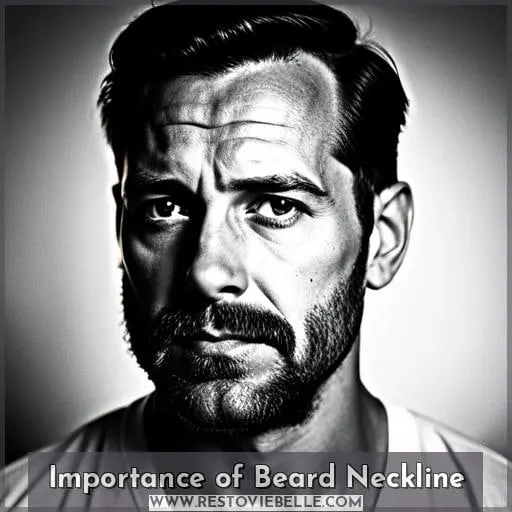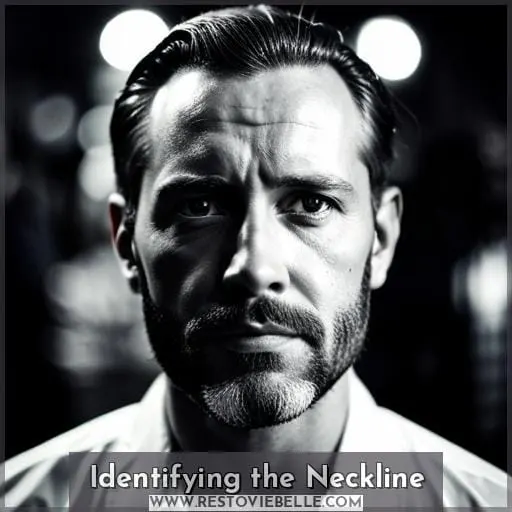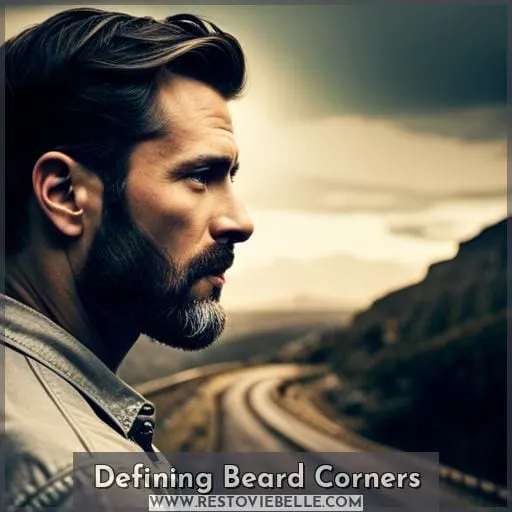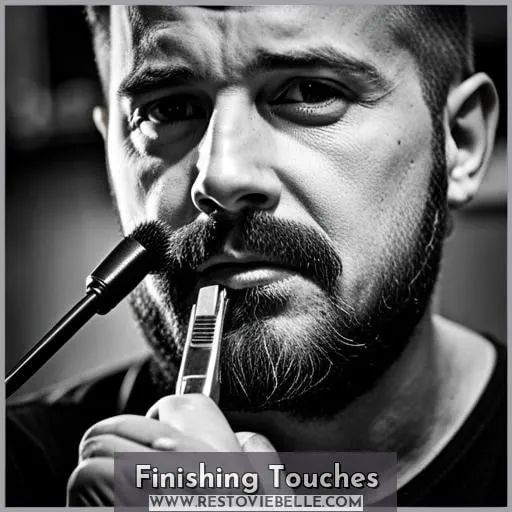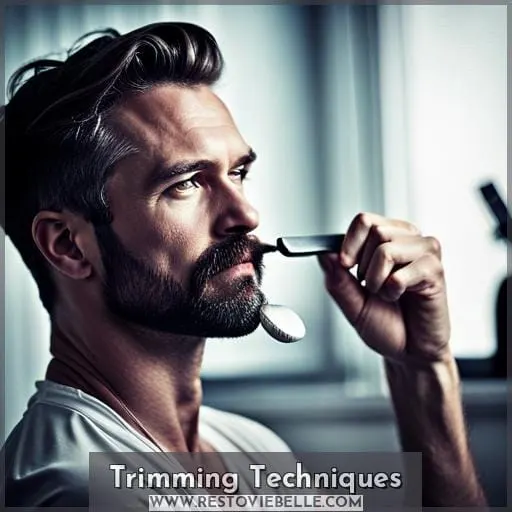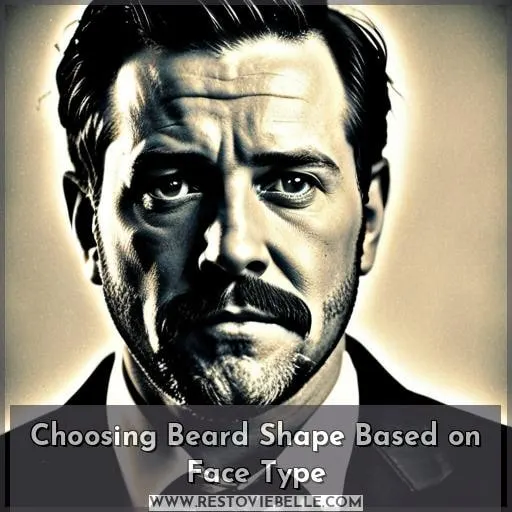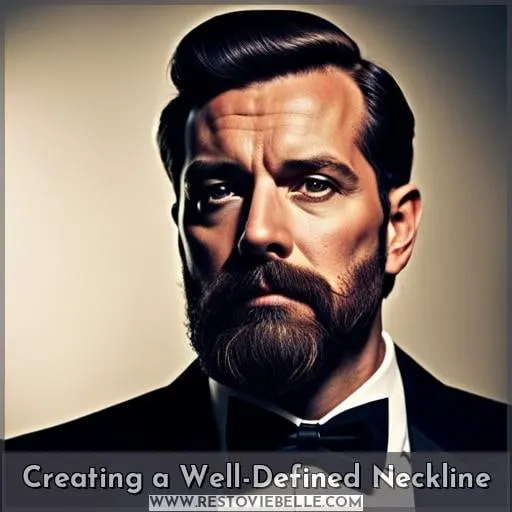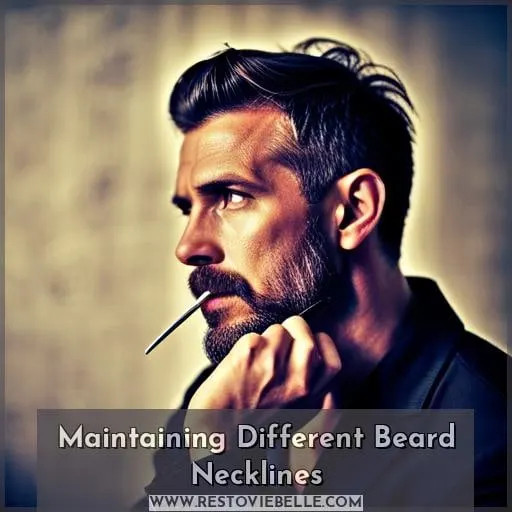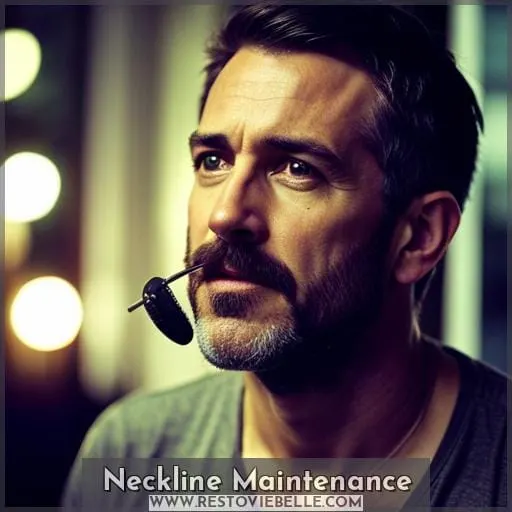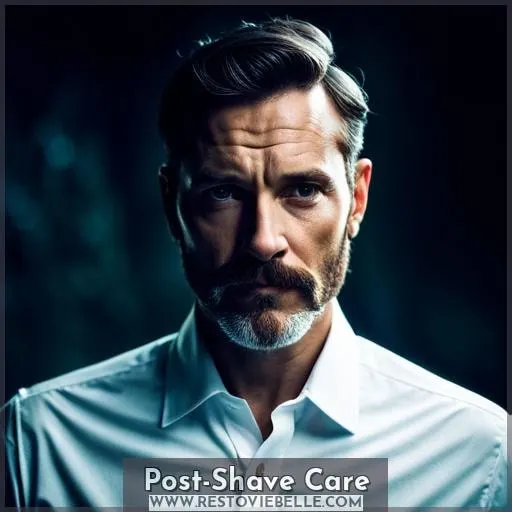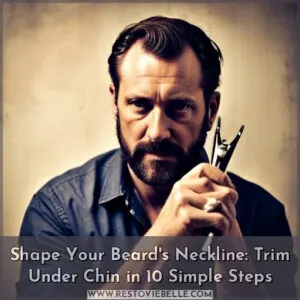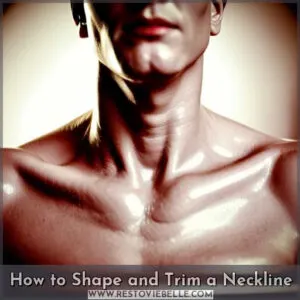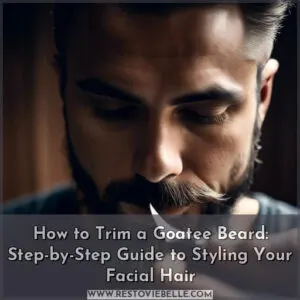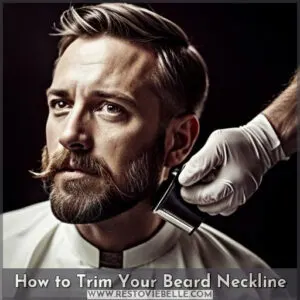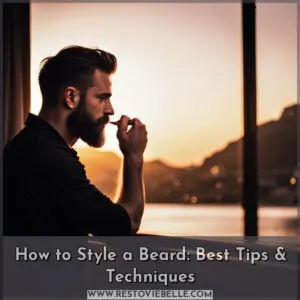This site is supported by our readers. We may earn a commission, at no cost to you, if you purchase through links.
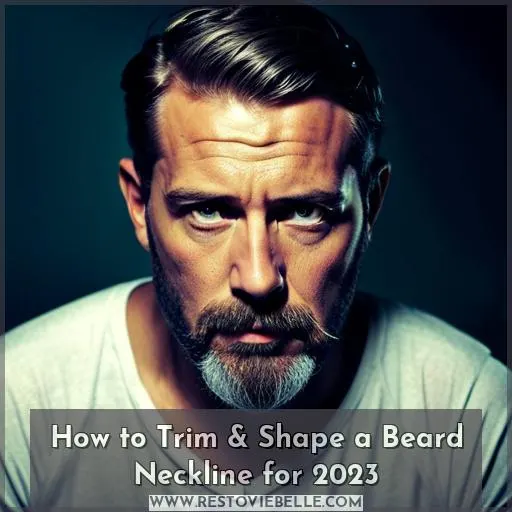 You’d think it would be easy – just grab a razor and go. But when it comes to defining your beard neckline, the wrong technique can give you an unflattering chin curtain that looks anything but manly.
You’d think it would be easy – just grab a razor and go. But when it comes to defining your beard neckline, the wrong technique can give you an unflattering chin curtain that looks anything but manly.
To get the perfect shape for 2023, you need to know how to identify where your neckline should be. You also need to choose between angular or rounded corners and use quality tools with precision in order to maintain different types of necklines.
Table Of Contents
- Key Takeaways
- Importance of Beard Neckline
- Identifying the Neckline
- Defining Beard Corners
- Finishing Touches
- Choosing the Right Tools
- Trimming Techniques
- Choosing Beard Shape Based on Face Type
- Creating a Well-Defined Neckline
- Maintaining Different Beard Necklines
- Neckline Maintenance
- Quality Tools and Techniques
- Post-Shave Care
- Frequently Asked Questions (FAQs)
- Conclusion
Key Takeaways
- Respect the natural head shape while shaping the neckline.
- Use electric trimmers or shears for precision in shaping under the chin.
- Trim in multiple passes for even results and to avoid irritation.
- Follow natural hair growth patterns for a neat appearance.
Importance of Beard Neckline
Maintaining a neat beard neckline is essential for achieving a polished and stylish look. Properly trimming the facial hair can make all the difference in your overall appearance, giving you an air of confidence and power.
Beard growth patterns are unique to each individual. Therefore, it’s important to understand how yours grows best before attempting any styling or maintenance. To achieve this, you can use electric trimmers with short cutting capabilities along with shears or clippers, depending on the desired beard length.
Razor blades should be sharpened regularly for optimal results while avoiding razor burn. Use products containing shea butter and glycolic acid post-shave for conditioning purposes too! The right shape will also depend on the face type.
Square faces may require more angular corners, whereas oblong ones might benefit from rounded edges instead.
Finally, regular upkeep is necessary to keep your style looking great. Aim to trim at least once every few weeks, depending on width preferences and desired outcome.
Identifying the Neckline
Starting your beard neckline trimming project requires identifying the right spot to begin. Utilize the Adam’s apple as a reference point and start trimming from the center of your jawline outward in an upward curve for a tailored look.
Ensure that you maintain this shape while keeping anything below the chin cleanly shaved off for the best results.
Determining Where to Trim
Start by determining where to trim your neckline for a neat appearance. Use the Adam’s apple as a reference and begin from the center, moving outward along the jawline with an upward curve. Trim below the earlobes to define the corners between angular or rounded shapes based on face type (round, oblong, square).
For optimum results, use an electric trimmer with short cutting capability up to 12mm for medium-length beards and 0.5mm for necklines. A razor is also an option, but caution is needed due to the risk of razor burn – shave with the grain instead of against it! Quality tools are essential.
Shears can give precise trimming, while beard grooming products like cleansers and oils will prevent razor bumps and ingrown hairs. They also condition the skin and hair naturally without harsh additives or fragrances.
Finding the Natural Line
Find your Adam’s apple to identify the natural line for a smooth neckline. To shape your beard under the chin, use quality tools such as electric trimmers or razors with sharp blades, and apply facial hair grooming techniques like trimming against the grain.
Choose a beard shape that best suits your face type, and adjust the length and sides according to square faces. Respect head shapes while trimming; create an even neckline by using finger placement on earlobes as reference points.
Trimming From the Center
Begin trimming from the center of your jawline and work outward to create a shape that follows your natural head’s curves. Use an angle that works with, not against, the contours of your face when shaping the beard.
Choose quality tools for precise control over facial hair maintenance and post-shave care products for healthy skin.
For optimal shaving technique, use trimmers or clippers depending on the desired length. Incorporate shears where needed for precision in longer beards. Respect natural head shapes as you trim while keeping in mind which beard shape would best balance out the face type.
Square faces require adjusting lengths and sides, whereas oblong faces require oval bearding to soften the look.
Don’t forget about regular maintenance – blades must stay sharp!
Maintaining the Neckline Shape
Maintaining your neckline shape requires regular trimming and upkeep. About 50% of men have reported that they regularly groom their beards for a neat look. Quality tools, such as electric trimmers, clippers, or shears with short cutting capability, should be used to define the beard’s shape and avoid razor bumps.
A skin guard is recommended for sensitive areas, while post-shave products can help maintain a healthy beard and skin.
When defining the neckline, choose the right length based on face type (round, oblong, square). Adjusting the sides can achieve an attractive balance in square faces. For ongoing care, replace blades regularly to prevent grooming mistakes.
Defining Beard Corners
To create a well-defined neckline, you should start by trimming the beard to guide your shaping. The vertical line below the earlobes needs to be trimmed in order to define angles or curves for either angular or rounded corners.
Trimming the Vertical Line
Trace the vertical line below your earlobes to define sharp corners and achieve a tailored look. For precision trimming, select beard tools such as trimmers, clippers, or shears based on neck width and desired length.
Achieve an even shave with electric foil razors for less irritation and prevention of razor bumps. When choosing a beard style, consider face shape: square beards balance round faces, while oval beards soften oblong ones.
Choosing Angular or Rounded Corners
Choose the perfect look for your face by picking angular or rounded corners for an elegant and stylish neckline. Beard length, care, and trimming technique all affect beard shape. Consider using a razor with a sharp blade to avoid razor burn when creating full beards.
Incorporate facial cleansers into your routine to prevent skin irritation and use quality beard products that include shea butter and glycolic acid for conditioning the skin underneath the beard hair.
Follow the Adam’s apple method while trimming if you’re looking to define strong angles at the earlobes or maintain rounder curves near the jawline area.
Finishing Touches
Completing your beard with a clean neck shave and achieving a proud collar-beard combination can elevate your look. Achieving this polished finish requires careful planning and attention to detail, from selecting the right tools to trimming techniques that respect natural hair growth patterns.
Completing With a Clean Neck Shave
For a polished look, finish off your beard with a quick neck shave and enjoy the benefits of up to 60 minutes of cordless trimming power. When using trimmers, clippers, or shears for quality tools, it’s important to follow proper shaving techniques, such as shaving with the grain.
Achieve an even result from the Adam’s apple method by starting from the center and moving outwards along the jawline.
For stubble or medium-length beards, use close trimming heads. For longer lengths, opt for shears and freehand clippers.
Regular maintenance includes cleaning and changing blades regularly, as well as pre and post-shave routines essential for optimal results.
Achieving a Proud Collar-beard Combination
You can achieve the perfect collar-beard combination by trimming with precision. To ensure an even finish, use quality tools such as electric trimmers and shears for longer beards. Respect the natural head shape when shaping and maintain a slight upward curve to avoid excessive roundness along the jawline.
Posture is important – define necklines using finger placement or earlobe connection to keep everything in balance.
Choosing the Right Tools
To get the perfect neckline for your beard, you need to choose the right tools. An electric trimmer with a short cutting capability is essential – select one with a range up to 12mm for medium and long beards, or 0.
5mm for more precision along the neckline. A razor can also be used, but caution needs to be taken as it may cause irritation or razor burn if not handled properly.
Electric Trimmer With Short Cutting Capability
Experience a clean cut with an electric trimmer that offers short cutting capability for precise results. Achieve any beard length, from stubble to medium-length, and tailor the trim level using adjustable settings on the device.
Use electric edgers to define your facial features and create sharp angles or rounded edges in different beard styles. Consider face definition when choosing a beard shape; adjust grooming frequency accordingly for maintenance of the desired look.
Trimmer Range for Different Beard Lengths
Choose an electric trimmer with a range of up to 12 mm for medium-length beards and as short as 0.5 mm for the neckline, so you can create your desired look with precision. Battery life is also important when choosing a trimmer – opt for one that lasts longer than 60 minutes if possible.
Additionally, consider the blade type; it should be sharp enough to provide clean cuts while still being gentle on skin and hair follicles.
Investing in quality tools such as clippers or shears can help maintain lengthier beard lengths while brushing helps keep everything neat throughout the day.
Optimal Trimmer for Neckline Precision
Maximize your look with a trimmer that offers neckline precision for the perfect finish. Opt for an electric trimmer capable of cutting as short as 0.5 mm and up to 12 mm. Use a Beardscape with zero blade if you desire more precise trimming, or consider an alternative razor, but be aware of potential razor burn.
Select quality tools to achieve visual enhancement while avoiding cuts, bumps, and irritation. Choose a trimmer equipped with shea butter and glycolic acid to soften beard hair and effectively care for men’s skincare needs.
Incorporate Adam’s apple reference points into shaping techniques. For example, when defining vertical lines below earlobes or creating collar-beard necklines.
Razor as an Alternative
If you’re looking for a quick and easy shave, consider using a razor as an alternative to electric trimmers for neckline precision.
Razors come in all shapes and sizes, so be sure to find the right one that suits your needs. Choose from manual or safety razors with blades of varying sharpness depending on the desired closeness of the shave.
Some alternatives include waxing kits specifically designed for beard shaping, as well as professional barbers who can help achieve desired results safely without risking any nicks or cuts along the way – whatever works best!
Enjoy improved confidence with enhanced facial features & overall look while still maintaining good health habits like regular moisturizing and exfoliating in the post-shave routine.
Trimming Techniques
To achieve the best results when trimming your beard under the chin, you need to be aware of a few techniques. Shave with the grain to minimize irritation and use an electric trimmer against it to achieve better results.
Identify the natural hair growth patterns while respecting the shape of your head in order to get an even trim in multiple passes.
Shaving With and Against the Grain
Shave in the direction of your hair growth for a smoother shave. Use an electric trimmer with short cutting capability to trim against the grain and achieve precision. For best results, use a sharp razor blade. Apply shaving cream before each shave.
Shear-trim facial hair based on length, respecting natural head shape and hair growth patterns. Avoiding razor bumps requires attention to detail – from prepping skin beforehand, using quality tools and products during, through post-shave care including moisturizers with glycolic acid and shea butter.
Identifying Natural Hair Growth Patterns
By paying close attention to your natural hair growth patterns, you can get an incredibly close trim and have a polished-looking beard neckline in no time! Take note of the direction of facial hair for improved styling.
Establish good grooming habits to ensure healthy hair while avoiding razor burn or other issues related to facial care. Pay particular attention when trimming around corners or shaping according to face shape – square beards may require extra length on the sides, whereas oval faces need more softening roundness.
To achieve maximum results with minimum effort, consider investing in quality tools such as electric trimmers and razors that offer precise cutting capabilities for better control over individual hairs without sacrificing overall health.
Respecting the Natural Head Shape
Respect your natural head shape while trimming for a stylish look that won’t leave you feeling over-groomed. When shaping the beard, take into account its length and your face type to ensure proper balance of features.
Quality tools such as trimmers or clippers are essential in achieving precise results without cuts or irritation. After shaving, prioritize post-shave care with products that contain shea butter and glycolic acid for conditioning and preventing razor burn.
Trimming in Multiple Passes
For optimum results, take the time to trim your beard in multiple passes, gliding through each one with ease. This sculpting technique allows you to better adjust for facial structure and desired beard length while avoiding razor burn.
Make sure blades are sharpened before use and stay mindful of hair growth patterns on the face as you move along.
To truly master this method, practice is key: pay close attention to areas that require more attention or extra care when shaping the neckline or outlining a jawline curve.
With patience comes power—the power of knowing how best to shape your look with precision and accuracy—so give yourself ample time to learn all the nuances involved in mastering this skill set until it becomes second nature!
Choosing Beard Shape Based on Face Type
When it comes to styling a beard, face shape plays an important role. For round faces, a square beard can balance the features, and for oblong shapes, an oval shape is ideal for softening. Those with square faces should consider adjusting the length of their beard as well as trimming along both sides of their face to achieve symmetry.
With careful consideration given to these factors, you can create your desired look quickly and easily.
Considering Round, Oblong, and Square Faces
When choosing a beard style, consider your face shape – round, oblong, or square – for an optimal look. To balance round faces, opt for a square beard that accentuates the cheekbones and jawline. An oval-shaped beard is perfect for softening long faces by adding width to the chin area.
For those with square-shaped faces, adjust both sides of your facial hair length as well as the front and back upper jawline when trimming.
Balancing Square Faces With a Square Beard
To balance a square face, opt for a neat and angular beard that follows the jawline around your chin.
- Beard length and sides to emphasize the natural head shape.
- Post-shave care with high-quality products like shea butter and glycolic acid.
- Quality tools such as electric trimmers, clippers, or shears for precision grooming.
- Respect natural hair growth patterns during trimming for effective results.
A well-defined neckline will create an overall polished look that is sure to make an impression! Grooming with quality tools plus post-shave care ensures healthy skin and long-lasting style – no matter your face type!
Softening Oblong Faces With an Oval Beard
An oval beard is a great way to soften oblong faces. It curves around the jawline and chin for an elegant look. When profiling face shape, use a trimmer range up to 12 mm for medium-length beards and 0.
5 mm for necklines. To avoid razor bumps, electric foil razors are best. Shea butter or glycolic acid products help with conditioning post-shave too. Don’t forget regular maintenance. Clean blades ensure effective grooming, while ongoing care keeps your beard healthy and handsome.
Choose length and sides based on face type, then trim from the right angle. Respect the head shape. Natural reference points guide the definition of the neckline’s style and the corners’ angularity or roundness as desired.
Adjusting Beard Length and Sides for Square Faces
For a square face, adjust your beard length and sides to craft an attractive silhouette. Trim shorter on the sides with a razor-sharp blade to achieve this look. Choose between angular or rounded corners to enhance facial features.
Avoid razor burn by using quality tools like electric trimmers, clippers, or shears. To keep it in place longer, use beard oil that contains shea butter and glycolic acid for conditioning post-shave.
Creating a Well-Defined Neckline
To create a well-defined beard neckline, start by trimming the beard to guide neckline shaping. Trim from the correct angle and identify the line using finger placement along your jawbone and earlobes as reference points.
With these steps in mind, you will be able to shape your desired look with precision and accuracy for an attractive finish.
Trimming the Beard to Guide Neckline Shaping
Start by defining your desired look, then carefully trim the beard to guide neckline shaping. Trim with quality tools and techniques for greater precision – electric trimmers, clippers, or shears – depending on the length of the desired beard.
Respect the natural head shape as you go and identify existing patterns in hair growth. When finished, don’t forget post-shave care to reduce irritation from razor burn: sharp blade razors are best for a clean finish; use products containing glycolic acid and shea butter to keep the skin healthy underneath the chin.
Trimming From the Right Angle
Angle your trimmer correctly to create a perfect neckline – no matter the style! Select the right angle when trimming beard length and creating a desired style. Opt for precise trimming with short cutting capability, such as an electric trimmer or razor.
Consider selecting angles that complement facial features and beard shape. Square faces benefit from angular corners, while oval faces should opt for rounded ones. When using clippers, shears, or freehand techniques to define edges, make sure they are sharp enough to achieve optimal results without pulling hairs out! As you work towards achieving your desired look, consider maintaining right angles throughout.
Identifying the Neckline Using Finger Placement
To get a well-defined neckline, place your fingers along the base of your jaw and use this as a guide to help you trim. Proper technique is important for avoiding cuts, while quality tools are essential for efficient results.
Post-shave care should be prioritized with high-quality products. Ongoing maintenance is key in achieving healthy skin and a handsome beard. To make sure each step of the grooming process goes smoothly, opt for an electric trimmer with short cutting capability.
Maintaining Different Beard Necklines
Maintaining a neat and stylish beard neckline is an important part of good grooming. Different kinds of beards require different levels of maintenance, from a stubble neckline for a natural look to defining the medium-length beard with precise trimming on the front, sides, and back of the upper jaw.
With careful attention and quality tools, you can keep your facial hair looking its best at all times.
Stubble Neckline for a Natural Look
For a natural look, trim your beard just below the jawline to create a stubble neckline. Choose the right length based on your face shape and desired style. Use razor blades or electric trimmers for precision, then finish with post-shave products for healthy skin and hair.
Don’t forget regular maintenance – keep it clean by replacing blades often! Achieving this look requires attention to detail: get creative with lengths and shapes while respecting your natural head shape throughout the process.
Medium-length Beard Neckline Definition
Give your medium-length beard an effortless definition with a close trim of the front, sides, back upper jaw, and lower part of the neck. Achieve precise results with tools such as an electric trimmer or clippers at different lengths – up to 12 mm for longer beards.
A zero blade Beardscape is recommended for ultra-accurate cutting and avoiding razor burn. Adjust your beard shape based on face type: square to balance round faces; oval to soften oblong ones.
Trimming the Front, Sides, and Back Upper Jaw
Trim the front, sides, and back of the upper jaw for a medium-length beard neckline that is even and precise. Use an electric trimmer with short cutting capability to cut at 0.5 mm or less for accuracy.
Choose between angular or rounded corners depending on your face shape and desired look. Respect the natural head shape while trimming in multiple passes to avoid unevenness – shaving with the grain also prevents irritation.
Neckline Maintenance
Maintaining a well-groomed look requires regular maintenance of the neckline. The frequency of trimming depends on your appearance goals, so it’s important to factor in how much time you have for upkeep before deciding on a style.
Knowing which product and techniques work best for your beard will help ensure that you keep up with the necessary grooming routine for a neat and tidy finish.
Regular Maintenance for a Well-groomed Look
To keep your beard looking its best, regular maintenance is key – but how often should you trim? Regular neckline upkeep will ensure a neat and professional appearance.
To avoid razor burn or ingrown hairs, use sharp blades with quality tools like electric trimmers for efficient grooming. Proper post-shave care is also important; moisturizing products like shea butter and glycolic acid can help soften the skin to prevent irritation.
Consider natural hair growth patterns when trimming to respect the head shape while achieving desired look goals – this may require multiple passes depending on the length of the beard. For optimal results, prioritize both pre & post-shave routines using techniques such as shaving with the grain, against the grain, and freehand clippers for precision styling with longer beards.
Investing in ongoing care will maintain healthy facial hair & skin, plus give a handsome finish!
Frequency of Trimming Based on Appearance Goals
Decide how often you should trim your beard neckline based on the desired look and appearance goals. Quality tools are essential to achieve this goal, as well as post-shave products for healthy skin and hair.
To maintain a neat look over time, ongoing care is key. Regular cleaning of blades and periodic trims will help keep facial hair looking its best. Consider beard length when selecting tools. Longer lengths require more precision, while shorter beards may benefit from electric trimmers or clippers with shorter cutting capability.
When choosing a shape, factor in face type. Angular lines may counterbalance round features, while oval shapes soften oblong faces effectively.
Keep up with maintenance for an attractive style that boosts confidence!
Quality Tools and Techniques
For a polished and well-defined beard, it is essential to have the right tools. Quality trimmers, clippers, or shears can help you achieve the desired look while maintaining efficiency. For longer beards, freehand clippers and shears are recommended for precision trimming.
Making sure to select quality products will ensure that your grooming routine goes smoothly and effectively each time.
Importance of Quality Tools for Efficiency
Choosing the right tools is essential for an efficient and close shave, so make sure to invest in quality razors, trimmers, and shears. Opt for electric foil razors with a sharp blade to prevent razor bumps or ingrown hairs.
Use pre-shave products that are rich in glycolic acid before you start grooming your beard.
Afterward, post-shave care with shea butter will help maintain healthy skin and hair follicles. Additionally, keep blades clean by regularly replacing them – it’s key to achieving optimal results! Investing in quality tools combined with ongoing maintenance yields a handsome beard every time without irritation or discomfort.
Choosing Trimmers, Clippers, or Shears
Selecting the right trimmer, clipper, or shears is key to achieving a precise and polished beard neckline. Blade selection depends on the desired look and beard length; trim angles determine evenness. Shear choice can provide precision with longer beards, while electric trimmers are effective for shorter lengths.
Cutting techniques vary depending on the natural head shape, so identify hair growth patterns accordingly. Respect the head shape when trimming against the grain using short cutting capability for efficient results without excessive roundness in the neckline corners.
Shears and Clippers for Longer Beard Lengths
For longer beards, shears and clippers provide precision with power. The key to achieving a neat beard neckline is using quality tools like zero blade Beardscapes or freehand clippers for accuracy and flexibility.
It’s important to avoid razor bumps by trimming against the grain when possible, which can only be done with electric trimmers that are capable of cutting short lengths of hair. Shears are an excellent choice for those who want more control over their trimming process as they have greater detail work capabilities than other tools.
With the right combination of products and techniques, you can create a precise neckline without any irritation or razor burn!
Post-Shave Care
Shaving with a sharp razor blade and using electric foil razors is essential for achieving a clean finish. These tools help reduce irritation, allowing you to enjoy the benefits of well-groomed facial hair without any discomfort.
Start your grooming routine off right by investing in quality shaving tools that offer precision and comfort.
Shaving With a Sharp Razor Blade
For a close and comfortable shave, use a sharp razor blade. Blades should be replaced regularly to ensure maximum sharpness for precision shaving. Electric foil razors can help prevent razor bumps and ingrown hairs caused by dull blades.
After the shave, apply post-shave products with shea butter or glycolic acid to condition skin and avoid irritation or burning sensations.
For best results, maintain good hygiene practices like cleaning tools regularly so you’ll always have that perfect close cut when it’s time for your next grooming routine – no more nicks or cuts needed!
Using Electric Foil Razors to Prevent Irritation
Electric foil razors can offer a smoother shave and prevent irritation, with up to 75% of users reporting less razor burn. To maximize the benefits, look for blades that have glycolic acid or shea butter as part of their post-shave care routine.
Glycolic acid helps reduce razor bumps and ingrown hairs, while shea butter provides soothing moisture that prevents dryness and skin damage from shaving.
For those who want an extra layer of protection against irritation, electric foil razors are an effective option due to their sharp blades, which reduce friction on the skin.
Frequently Asked Questions (FAQs)
What products should I use to reduce ingrown hairs?
Regularly clean and replace blades, use electric foil razors, and choose high-quality post-shave products with shea butter or glycolic acid to reduce ingrown hairs.
How often should I trim my beard neckline?
Trim your beard neckline regularly for an impeccably groomed look. Go beyond regular maintenance to achieve a perfect shape and style that will make heads turn! Exaggerate the angles, curves, and lengths of your beard for extra definition – you won’t regret it.
With the right tools and techniques, you can make sure every trim is immaculate.
How do I shape my beard to create a sharper look?
To create a sharper look, carefully trim your neckline to define the shape of your chin. Use an electric trimmer with adjustable settings and a zero blade for precision. Choose based on face type for optimal results: angular corners work best with round faces; an oval beard softens oblong ones.
How do I maintain a stubble neckline?
Maintaining a stubble neckline is easy with the right tools and techniques. Get a close trim with an electric trimmer or use shears for precision on longer beards. Shave against the grain to reduce irritation and remember to follow the natural head shape during trimming.
What is the best way to achieve a collar-beard neckline combination?
Shape your beard neckline to create a polished look and gain mastery over your style. Combining the proud collar with a well-defined neckline will give you an authoritative aura that liberates you from the mundane.
Start by trimming, defining corners, and adding finishing touches for evenness. Then, choose a shape based on your face type for optimal results.
Conclusion
You’ve come a long way in your quest to shape the perfect beard neckline for 2023. From determining where to trim to finding the natural line, you’ve certainly mastered the art of trimming and shaping a beard under the chin.
You’ve chosen the right tools and techniques and have found the perfect combination of shears and clippers for precision with longer beard lengths. You’ve also identified the right products for post-shave care to ensure a healthy beard and skin.
The key to success is ongoing care and regular blade maintenance, so don’t forget to prioritize your pre and post-shave routines.

